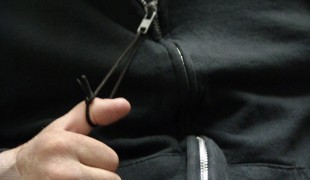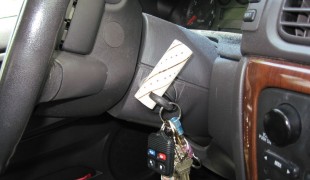- 7337
- 486
- 5
- 7
- 0
- Help Ukraine
About the solution
Zippers, be they in trousers or dressers, are quite often problematic for people with arthritis and related conditions. They may be too small or difficult to pull. This innovation was shared online aiming at providing a simple, cheap solution for the problem.
Three materials are required: a cup hook, a dowel and a PVC T-joint - all of them can be bought in a hardware store and it is advisable to check if the dowel fits in the PVC joint. Then, it all can be done quite easily: you screw the cup hook in one of the dowel's ends and then attach the other end to the PVC T-joint. This way, you will have a cheap, light, and very manageable device that can be carried without much trouble. Check the pictures, for they can give you further guidance.
Adapted from: http://bit.ly/2j7lNVG
这些解决方案不应包括使用药物,化学品或生物制品(包括食品);创伤性设备;冒犯性的,商业或内在危险的内容。该解决方案未经医学验证。请谨慎进行!如果您有任何疑问,请咨询健康专家。
DISCLAIMER: This story was written by someone who is not the author of the solution, therefore please be advised that, although it was written with the utmost respect for the innovation and the innovator, there can be some incorrect statements. If you find any errors please contact the patient Innovation team via info@patient-innovation.com
-
-
601
-
0
-
9331

Man creates an aid to help people with hand disability
(SELF)-CARE: DRESSING: Dressing independently.
CAREGIVING
Arthritis
Brain Stroke
Paralysis
Strategy/Tip
Body-Worn solutions (Clothing, accessories, shoes, sensors...)
Muscle weakness
Limited range of motion
Muscle pain or stiffness
Reduced grip force (grip)
Loss of muscle coordination
Muscle cramps or spasms
Joint deformity
Joint redness or warmth
Fatigue
Muscle twitching
Cold hands or feet
Numbness or tingling in the extremities
Joint pain or swelling
Managing pain
Promoting self-management
Rehabilitating After Stroke
Caregiving Support
Orthopedics
Rheumatology
Vascular Surgery
United States
-
-
-
553
-
0
-
9000

Man creates device to help to put on socks, shoes and even trousers
Grip
(SELF)-CARE: DRESSING: Dressing independently.
BODY BALANCE: Maintaining body balance
STANDING UP: Standing up from a seated position
Knee Deformity
Assistive Daily Life Device (to help ADL)
Strategy/Tip
Muscle weakness
Limited range of motion
Muscle pain or stiffness
Reduced grip force (grip)
Loss of muscle coordination
Muscle cramps or spasms
Joint deformity
Joint redness or warmth
Swelling or inflammation
Difficulty bearing weight
Muscle twitching
Difficulty standing from a seated position
Difficulty getting up from the floor
Numbness or tingling in the extremities
Joint pain or swelling
Restoring mobility
Promoting self-management
Preserving Organ Function
Rehabilitating After Stroke
Managing Neurological Disorders
Recovering from Traumatic Injuries
Maintaining Balance and Mobility
Preventing (Vaccination, Protection, Falls, Research/Mapping)
Caregiving Support
Internal Medicine
Neurology
Orthopedics
Physical Medicine and Rehabilitation
Rheumatology
Sports Medicine
Vascular Surgery
United States
-
-
-
512
-
0
-
8359

Son created a key turning aid to avoid wrist twisting motion
Grip
CAREGIVING
Arthritis
Assistive Daily Life Device (to help ADL)
Restoring mobility
Managing pain
Promoting self-management
Managing Neurological Disorders
Preventing (Vaccination, Protection, Falls, Research/Mapping)
Raise awareness
Caregiving Support
General and Family Medicine
Orthopedics
Rheumatology
United States
-
 zh
zh